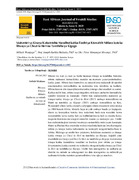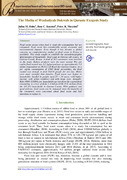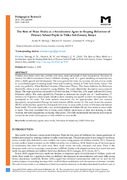Combined influence of choice of media channel, timing of media messages, and frequency of media messages on perception of wildlife conservation discourse in Kenya
| dc.contributor.author | JINARO, PAUL MBURU | |
| dc.contributor.author | MACHARIA, JULIET WAMBUI | |
| dc.contributor.author | MBURU, PAUL KIUMBE | |
| dc.date.accessioned | 2024-08-14T12:23:00Z | |
| dc.date.available | 2024-08-14T12:23:00Z | |
| dc.date.issued | 2022-04 | |
| dc.identifier.citation | Journal of Communication and Media Research, Vol. 14, No. 1, April 2022, pp. 24-33 | en_US |
| dc.identifier.uri | file:///C:/Users/KarU%20LIB/Downloads/JCMR%2014.1%203%20Jinaro,%20Macharia%20&%20Mburu.pdf | |
| dc.identifier.uri | https://karuspace.karu.ac.ke/handle/20.500.12092/3147 | |
| dc.description | Abstract | en_US |
| dc.description.abstract | Audience perception of wildlife conservation discourse in Kenya has been negative as evidenced in results of conservation efforts. The purpose of this study was to interrogate the combined influence of choice of media channel, timing of media messages, and frequency of media messages on perception of wildlife conservation discourse in Kenya. The study employed convergent parallel mixed methods design. Population comprised of three groups namely; media practitioners; residents living next to national parks in four out of eight conservation areas in Kenya; and park managers in the four national parks. A questionnaire was administered to 83 human-wildlife conflict resolution committee members. Questionnaire generated quantitative data while qualitative data was generated from interviews with six media practitioners, 12 park managers and Focus Group Discussions with four groups of human wildlife conflict resolution committee officials. The study applied qualitative and quantitative analytical techniques. Results indicated choice of media, frequency of messages, and timing of media messages when combined have a significant influence on audience perception of wildlife conservation discourse in Kenya. However, the targeted communities expressed concerns that media tended to prioritize reporting on wildlife and often ignored the plight of people. The study recommends media should also communicate the plight of communities. | en_US |
| dc.language.iso | en | en_US |
| dc.publisher | Karatina University | en_US |
| dc.subject | Audience Perception | en_US |
| dc.subject | Human Wildlife Conflict | en_US |
| dc.subject | Choice of Media | en_US |
| dc.subject | Timing of Media Messages | en_US |
| dc.subject | Frequency of Media Messages | en_US |
| dc.title | Combined influence of choice of media channel, timing of media messages, and frequency of media messages on perception of wildlife conservation discourse in Kenya | en_US |
| dc.type | Article | en_US |



